Case Analysis: Bank's CSR Campaign, Risks, and Recommendations
VerifiedAdded on 2023/01/19
|11
|3353
|81
Case Study
AI Summary
This case analysis examines a bank's corporate social responsibility (CSR) campaign, launched in response to a series of scandals and aimed at improving its public image and addressing social issues like the #MeToo movement. The assignment identifies problems arising from the campaign, particularly public distrust due to the bank's past actions, and analyzes the negative backlash. It explores the perspectives of social and organizational isolation, and utilizes four sociological paradigms to examine the campaign's methodology. The analysis includes a literature review on CSR strategies and their importance in building brand recognition and trust. The case study synthesizes risk analysis, focusing on potential negative impacts of the campaign, and provides recommendations for risk mitigation. The study emphasizes the importance of addressing the public's negative perceptions and utilizing paradigm shifts to effectively change individual perspectives and behaviors, ultimately aiming to improve the campaign's outcomes and the bank's reputation.
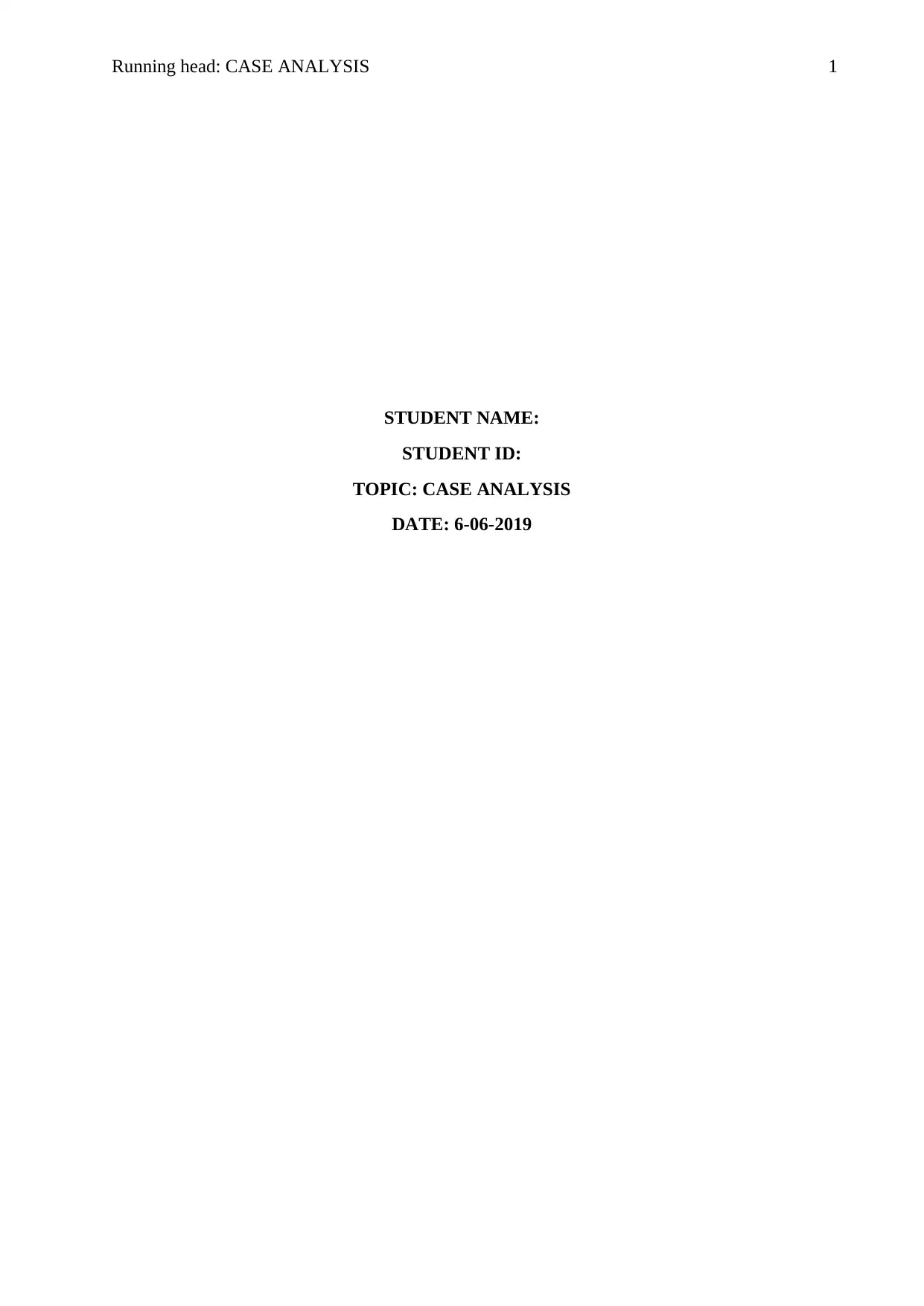
Running head: CASE ANALYSIS 1
STUDENT NAME:
STUDENT ID:
TOPIC: CASE ANALYSIS
DATE: 6-06-2019
STUDENT NAME:
STUDENT ID:
TOPIC: CASE ANALYSIS
DATE: 6-06-2019
Paraphrase This Document
Need a fresh take? Get an instant paraphrase of this document with our AI Paraphraser

CASE ANALYSIS 2
Table of Contents
1 ABSTRACT........................................................................................................................2
2 INTRODUCTION..............................................................................................................2
2.1 Problem Statement.......................................................................................................2
2.1.1 Perspective of Social Isolation (Individual).........................................................2
2.1.2 Perspective of Organizational Isolation from Society.........................................2
3 METHODOLOGY.............................................................................................................2
4 Literature (Find and Generate)...........................................................................................2
5 Risk Analysis Recommendations to your Organization ( Synthesise )..............................2
6 Critical Discussions............................................................................................................2
Table of Contents
1 ABSTRACT........................................................................................................................2
2 INTRODUCTION..............................................................................................................2
2.1 Problem Statement.......................................................................................................2
2.1.1 Perspective of Social Isolation (Individual).........................................................2
2.1.2 Perspective of Organizational Isolation from Society.........................................2
3 METHODOLOGY.............................................................................................................2
4 Literature (Find and Generate)...........................................................................................2
5 Risk Analysis Recommendations to your Organization ( Synthesise )..............................2
6 Critical Discussions............................................................................................................2
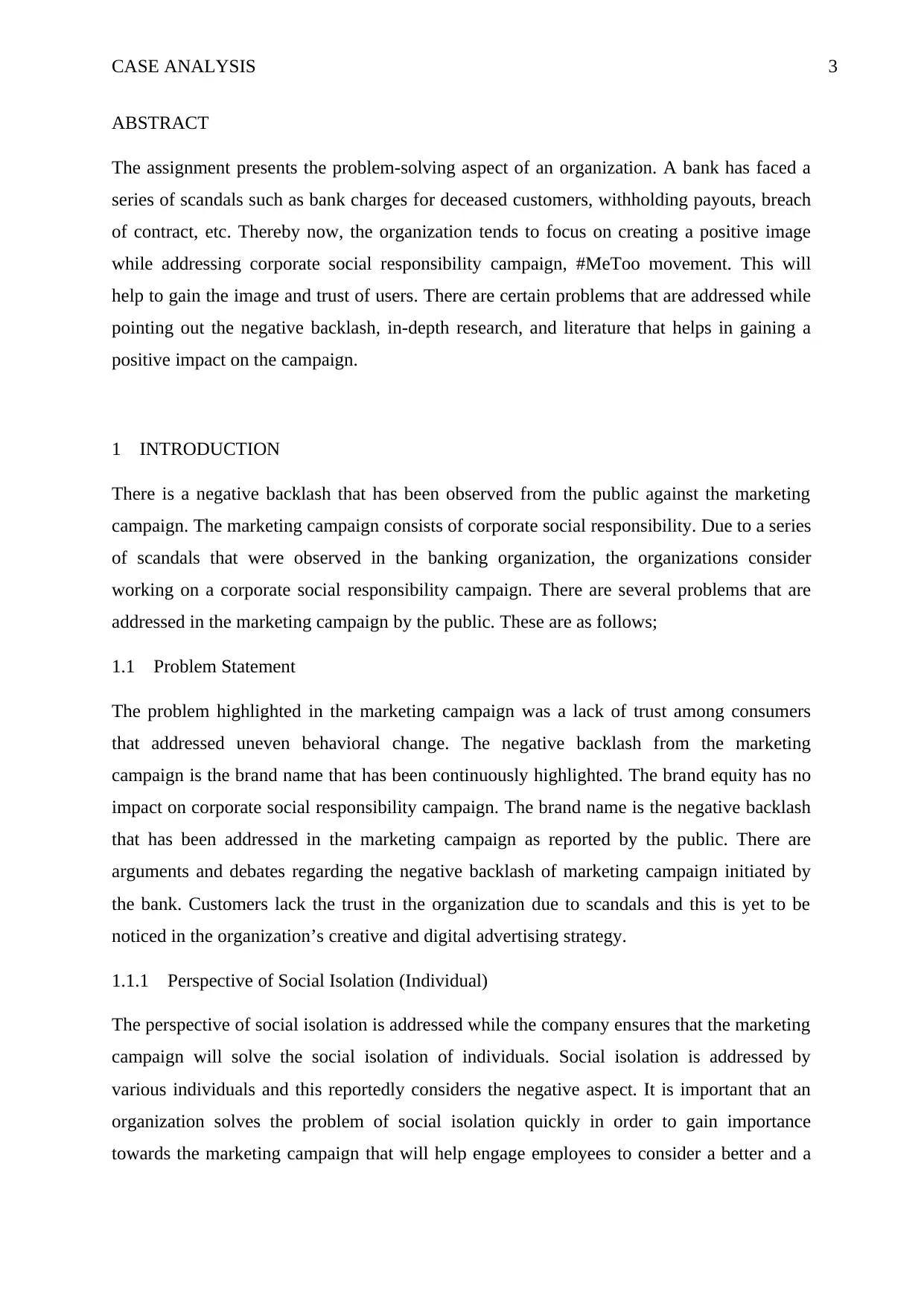
CASE ANALYSIS 3
ABSTRACT
The assignment presents the problem-solving aspect of an organization. A bank has faced a
series of scandals such as bank charges for deceased customers, withholding payouts, breach
of contract, etc. Thereby now, the organization tends to focus on creating a positive image
while addressing corporate social responsibility campaign, #MeToo movement. This will
help to gain the image and trust of users. There are certain problems that are addressed while
pointing out the negative backlash, in-depth research, and literature that helps in gaining a
positive impact on the campaign.
1 INTRODUCTION
There is a negative backlash that has been observed from the public against the marketing
campaign. The marketing campaign consists of corporate social responsibility. Due to a series
of scandals that were observed in the banking organization, the organizations consider
working on a corporate social responsibility campaign. There are several problems that are
addressed in the marketing campaign by the public. These are as follows;
1.1 Problem Statement
The problem highlighted in the marketing campaign was a lack of trust among consumers
that addressed uneven behavioral change. The negative backlash from the marketing
campaign is the brand name that has been continuously highlighted. The brand equity has no
impact on corporate social responsibility campaign. The brand name is the negative backlash
that has been addressed in the marketing campaign as reported by the public. There are
arguments and debates regarding the negative backlash of marketing campaign initiated by
the bank. Customers lack the trust in the organization due to scandals and this is yet to be
noticed in the organization’s creative and digital advertising strategy.
1.1.1 Perspective of Social Isolation (Individual)
The perspective of social isolation is addressed while the company ensures that the marketing
campaign will solve the social isolation of individuals. Social isolation is addressed by
various individuals and this reportedly considers the negative aspect. It is important that an
organization solves the problem of social isolation quickly in order to gain importance
towards the marketing campaign that will help engage employees to consider a better and a
ABSTRACT
The assignment presents the problem-solving aspect of an organization. A bank has faced a
series of scandals such as bank charges for deceased customers, withholding payouts, breach
of contract, etc. Thereby now, the organization tends to focus on creating a positive image
while addressing corporate social responsibility campaign, #MeToo movement. This will
help to gain the image and trust of users. There are certain problems that are addressed while
pointing out the negative backlash, in-depth research, and literature that helps in gaining a
positive impact on the campaign.
1 INTRODUCTION
There is a negative backlash that has been observed from the public against the marketing
campaign. The marketing campaign consists of corporate social responsibility. Due to a series
of scandals that were observed in the banking organization, the organizations consider
working on a corporate social responsibility campaign. There are several problems that are
addressed in the marketing campaign by the public. These are as follows;
1.1 Problem Statement
The problem highlighted in the marketing campaign was a lack of trust among consumers
that addressed uneven behavioral change. The negative backlash from the marketing
campaign is the brand name that has been continuously highlighted. The brand equity has no
impact on corporate social responsibility campaign. The brand name is the negative backlash
that has been addressed in the marketing campaign as reported by the public. There are
arguments and debates regarding the negative backlash of marketing campaign initiated by
the bank. Customers lack the trust in the organization due to scandals and this is yet to be
noticed in the organization’s creative and digital advertising strategy.
1.1.1 Perspective of Social Isolation (Individual)
The perspective of social isolation is addressed while the company ensures that the marketing
campaign will solve the social isolation of individuals. Social isolation is addressed by
various individuals and this reportedly considers the negative aspect. It is important that an
organization solves the problem of social isolation quickly in order to gain importance
towards the marketing campaign that will help engage employees to consider a better and a
⊘ This is a preview!⊘
Do you want full access?
Subscribe today to unlock all pages.

Trusted by 1+ million students worldwide
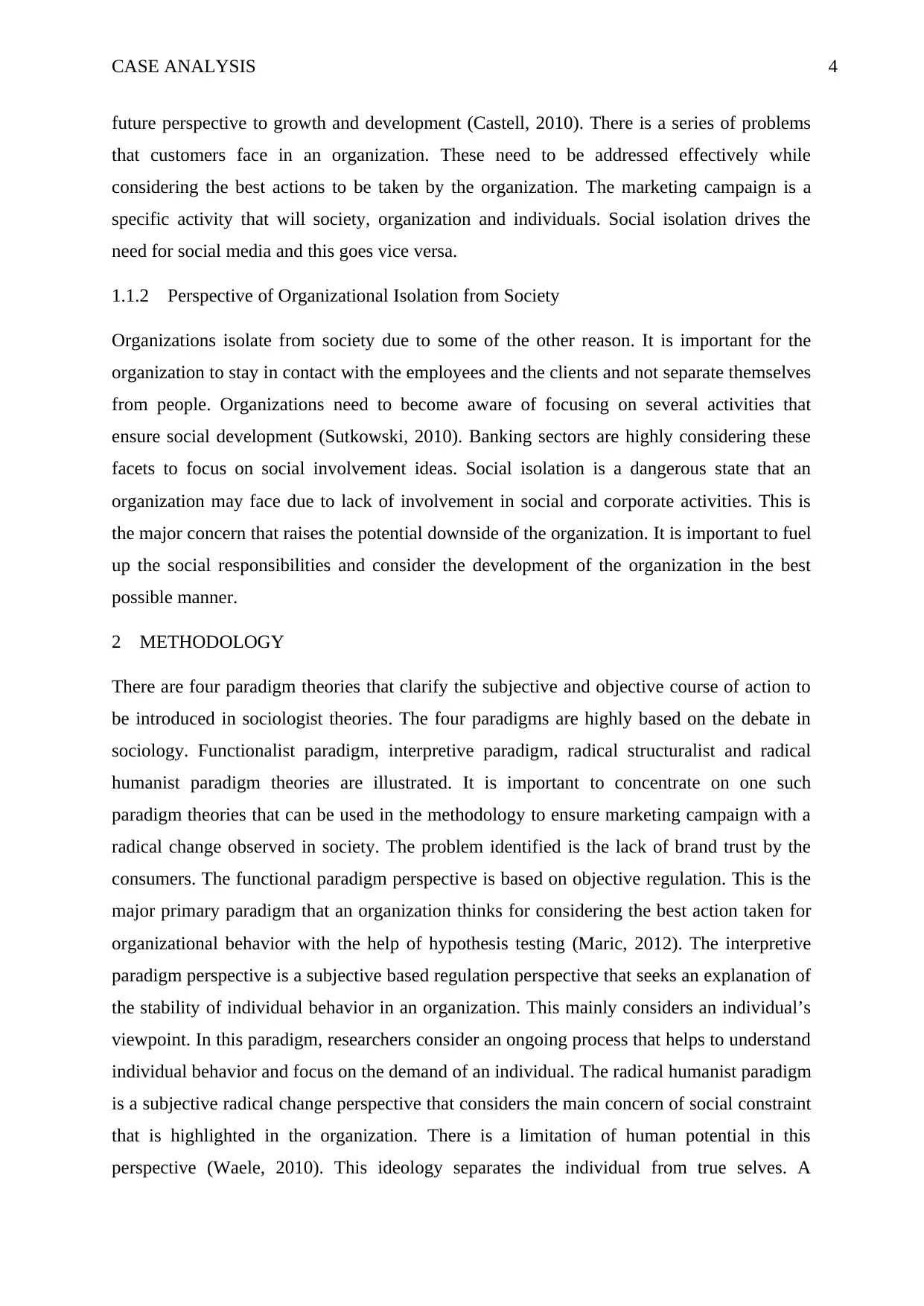
CASE ANALYSIS 4
future perspective to growth and development (Castell, 2010). There is a series of problems
that customers face in an organization. These need to be addressed effectively while
considering the best actions to be taken by the organization. The marketing campaign is a
specific activity that will society, organization and individuals. Social isolation drives the
need for social media and this goes vice versa.
1.1.2 Perspective of Organizational Isolation from Society
Organizations isolate from society due to some of the other reason. It is important for the
organization to stay in contact with the employees and the clients and not separate themselves
from people. Organizations need to become aware of focusing on several activities that
ensure social development (Sutkowski, 2010). Banking sectors are highly considering these
facets to focus on social involvement ideas. Social isolation is a dangerous state that an
organization may face due to lack of involvement in social and corporate activities. This is
the major concern that raises the potential downside of the organization. It is important to fuel
up the social responsibilities and consider the development of the organization in the best
possible manner.
2 METHODOLOGY
There are four paradigm theories that clarify the subjective and objective course of action to
be introduced in sociologist theories. The four paradigms are highly based on the debate in
sociology. Functionalist paradigm, interpretive paradigm, radical structuralist and radical
humanist paradigm theories are illustrated. It is important to concentrate on one such
paradigm theories that can be used in the methodology to ensure marketing campaign with a
radical change observed in society. The problem identified is the lack of brand trust by the
consumers. The functional paradigm perspective is based on objective regulation. This is the
major primary paradigm that an organization thinks for considering the best action taken for
organizational behavior with the help of hypothesis testing (Maric, 2012). The interpretive
paradigm perspective is a subjective based regulation perspective that seeks an explanation of
the stability of individual behavior in an organization. This mainly considers an individual’s
viewpoint. In this paradigm, researchers consider an ongoing process that helps to understand
individual behavior and focus on the demand of an individual. The radical humanist paradigm
is a subjective radical change perspective that considers the main concern of social constraint
that is highlighted in the organization. There is a limitation of human potential in this
perspective (Waele, 2010). This ideology separates the individual from true selves. A
future perspective to growth and development (Castell, 2010). There is a series of problems
that customers face in an organization. These need to be addressed effectively while
considering the best actions to be taken by the organization. The marketing campaign is a
specific activity that will society, organization and individuals. Social isolation drives the
need for social media and this goes vice versa.
1.1.2 Perspective of Organizational Isolation from Society
Organizations isolate from society due to some of the other reason. It is important for the
organization to stay in contact with the employees and the clients and not separate themselves
from people. Organizations need to become aware of focusing on several activities that
ensure social development (Sutkowski, 2010). Banking sectors are highly considering these
facets to focus on social involvement ideas. Social isolation is a dangerous state that an
organization may face due to lack of involvement in social and corporate activities. This is
the major concern that raises the potential downside of the organization. It is important to fuel
up the social responsibilities and consider the development of the organization in the best
possible manner.
2 METHODOLOGY
There are four paradigm theories that clarify the subjective and objective course of action to
be introduced in sociologist theories. The four paradigms are highly based on the debate in
sociology. Functionalist paradigm, interpretive paradigm, radical structuralist and radical
humanist paradigm theories are illustrated. It is important to concentrate on one such
paradigm theories that can be used in the methodology to ensure marketing campaign with a
radical change observed in society. The problem identified is the lack of brand trust by the
consumers. The functional paradigm perspective is based on objective regulation. This is the
major primary paradigm that an organization thinks for considering the best action taken for
organizational behavior with the help of hypothesis testing (Maric, 2012). The interpretive
paradigm perspective is a subjective based regulation perspective that seeks an explanation of
the stability of individual behavior in an organization. This mainly considers an individual’s
viewpoint. In this paradigm, researchers consider an ongoing process that helps to understand
individual behavior and focus on the demand of an individual. The radical humanist paradigm
is a subjective radical change perspective that considers the main concern of social constraint
that is highlighted in the organization. There is a limitation of human potential in this
perspective (Waele, 2010). This ideology separates the individual from true selves. A
Paraphrase This Document
Need a fresh take? Get an instant paraphrase of this document with our AI Paraphraser
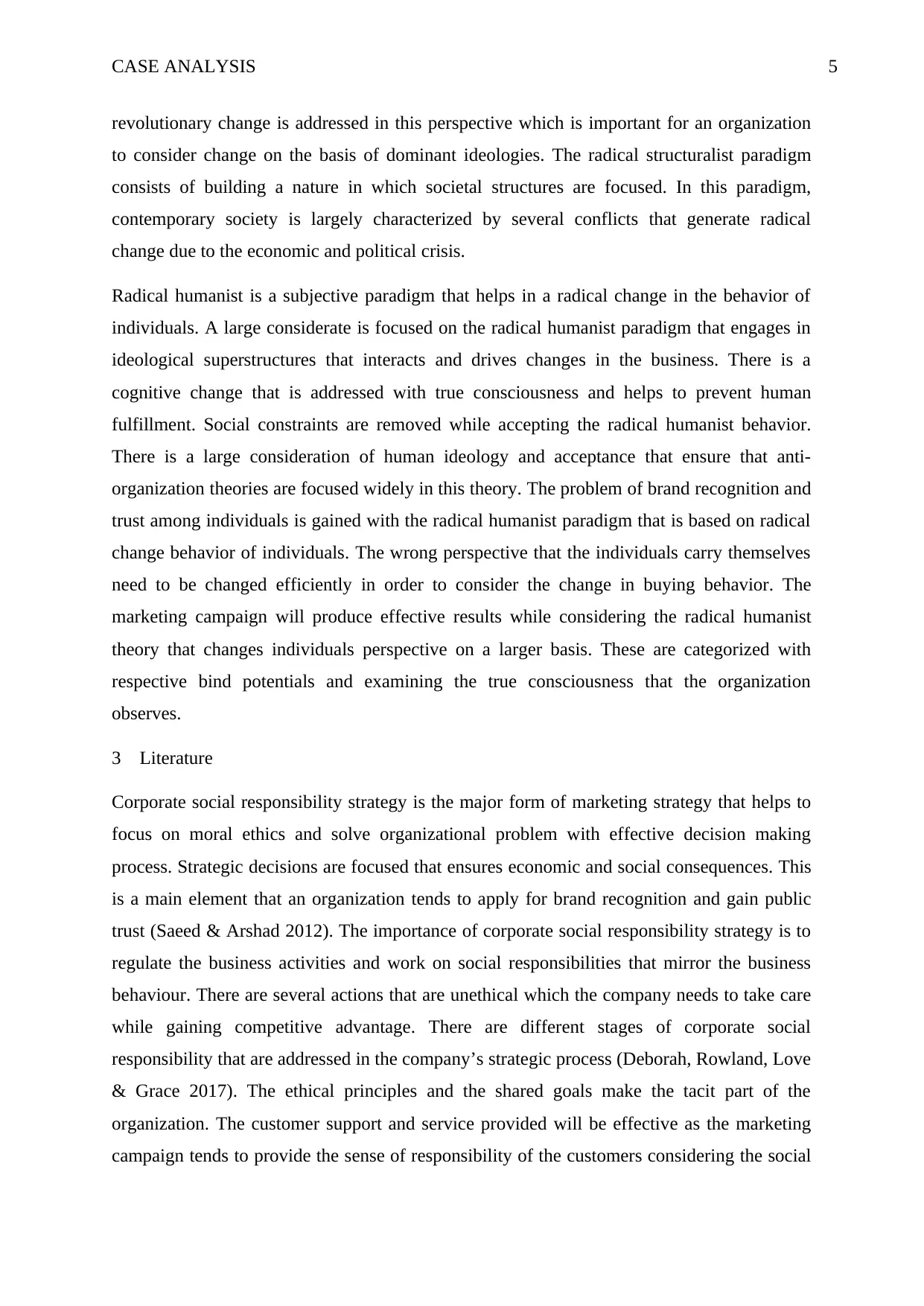
CASE ANALYSIS 5
revolutionary change is addressed in this perspective which is important for an organization
to consider change on the basis of dominant ideologies. The radical structuralist paradigm
consists of building a nature in which societal structures are focused. In this paradigm,
contemporary society is largely characterized by several conflicts that generate radical
change due to the economic and political crisis.
Radical humanist is a subjective paradigm that helps in a radical change in the behavior of
individuals. A large considerate is focused on the radical humanist paradigm that engages in
ideological superstructures that interacts and drives changes in the business. There is a
cognitive change that is addressed with true consciousness and helps to prevent human
fulfillment. Social constraints are removed while accepting the radical humanist behavior.
There is a large consideration of human ideology and acceptance that ensure that anti-
organization theories are focused widely in this theory. The problem of brand recognition and
trust among individuals is gained with the radical humanist paradigm that is based on radical
change behavior of individuals. The wrong perspective that the individuals carry themselves
need to be changed efficiently in order to consider the change in buying behavior. The
marketing campaign will produce effective results while considering the radical humanist
theory that changes individuals perspective on a larger basis. These are categorized with
respective bind potentials and examining the true consciousness that the organization
observes.
3 Literature
Corporate social responsibility strategy is the major form of marketing strategy that helps to
focus on moral ethics and solve organizational problem with effective decision making
process. Strategic decisions are focused that ensures economic and social consequences. This
is a main element that an organization tends to apply for brand recognition and gain public
trust (Saeed & Arshad 2012). The importance of corporate social responsibility strategy is to
regulate the business activities and work on social responsibilities that mirror the business
behaviour. There are several actions that are unethical which the company needs to take care
while gaining competitive advantage. There are different stages of corporate social
responsibility that are addressed in the company’s strategic process (Deborah, Rowland, Love
& Grace 2017). The ethical principles and the shared goals make the tacit part of the
organization. The customer support and service provided will be effective as the marketing
campaign tends to provide the sense of responsibility of the customers considering the social
revolutionary change is addressed in this perspective which is important for an organization
to consider change on the basis of dominant ideologies. The radical structuralist paradigm
consists of building a nature in which societal structures are focused. In this paradigm,
contemporary society is largely characterized by several conflicts that generate radical
change due to the economic and political crisis.
Radical humanist is a subjective paradigm that helps in a radical change in the behavior of
individuals. A large considerate is focused on the radical humanist paradigm that engages in
ideological superstructures that interacts and drives changes in the business. There is a
cognitive change that is addressed with true consciousness and helps to prevent human
fulfillment. Social constraints are removed while accepting the radical humanist behavior.
There is a large consideration of human ideology and acceptance that ensure that anti-
organization theories are focused widely in this theory. The problem of brand recognition and
trust among individuals is gained with the radical humanist paradigm that is based on radical
change behavior of individuals. The wrong perspective that the individuals carry themselves
need to be changed efficiently in order to consider the change in buying behavior. The
marketing campaign will produce effective results while considering the radical humanist
theory that changes individuals perspective on a larger basis. These are categorized with
respective bind potentials and examining the true consciousness that the organization
observes.
3 Literature
Corporate social responsibility strategy is the major form of marketing strategy that helps to
focus on moral ethics and solve organizational problem with effective decision making
process. Strategic decisions are focused that ensures economic and social consequences. This
is a main element that an organization tends to apply for brand recognition and gain public
trust (Saeed & Arshad 2012). The importance of corporate social responsibility strategy is to
regulate the business activities and work on social responsibilities that mirror the business
behaviour. There are several actions that are unethical which the company needs to take care
while gaining competitive advantage. There are different stages of corporate social
responsibility that are addressed in the company’s strategic process (Deborah, Rowland, Love
& Grace 2017). The ethical principles and the shared goals make the tacit part of the
organization. The customer support and service provided will be effective as the marketing
campaign tends to provide the sense of responsibility of the customers considering the social
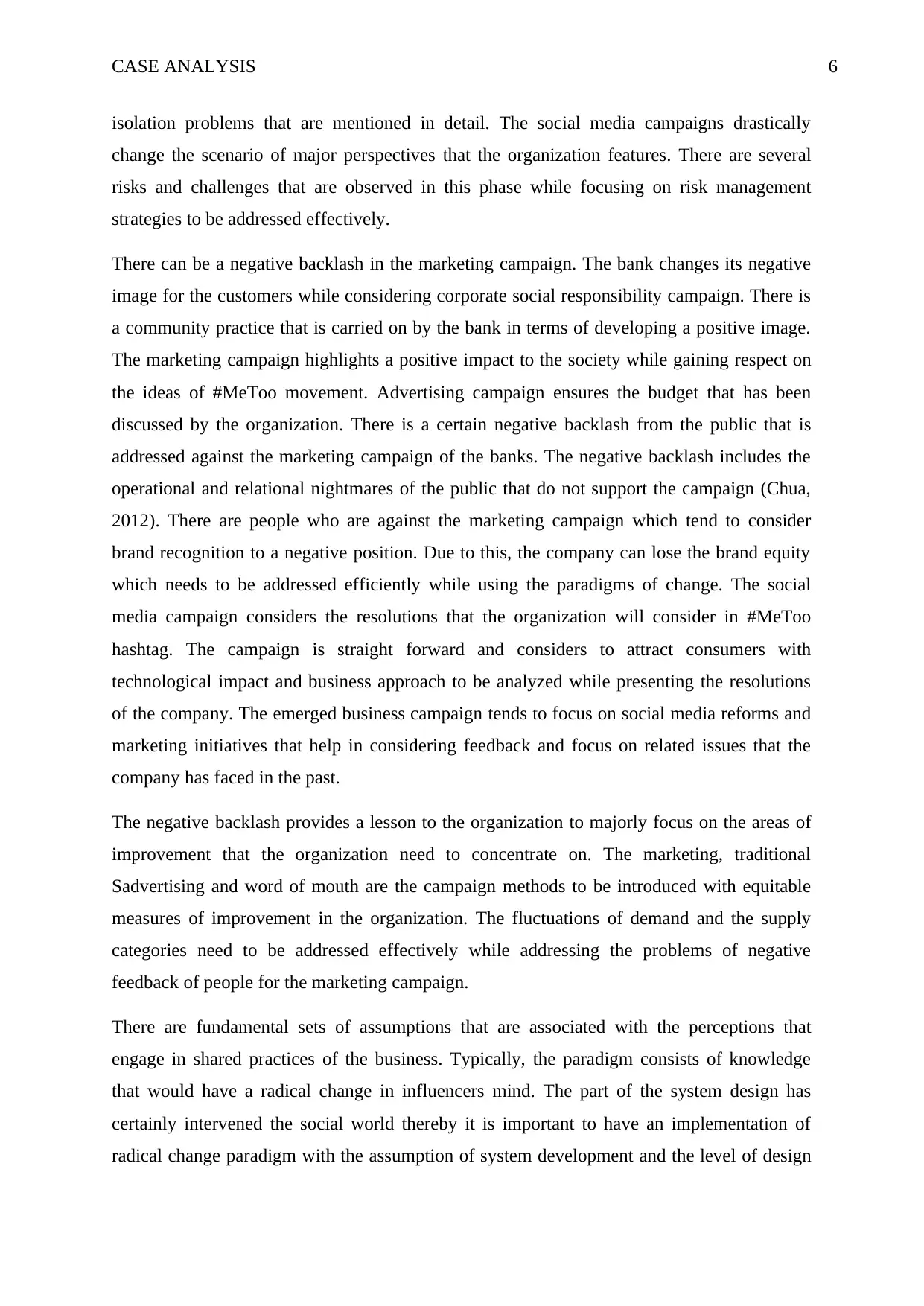
CASE ANALYSIS 6
isolation problems that are mentioned in detail. The social media campaigns drastically
change the scenario of major perspectives that the organization features. There are several
risks and challenges that are observed in this phase while focusing on risk management
strategies to be addressed effectively.
There can be a negative backlash in the marketing campaign. The bank changes its negative
image for the customers while considering corporate social responsibility campaign. There is
a community practice that is carried on by the bank in terms of developing a positive image.
The marketing campaign highlights a positive impact to the society while gaining respect on
the ideas of #MeToo movement. Advertising campaign ensures the budget that has been
discussed by the organization. There is a certain negative backlash from the public that is
addressed against the marketing campaign of the banks. The negative backlash includes the
operational and relational nightmares of the public that do not support the campaign (Chua,
2012). There are people who are against the marketing campaign which tend to consider
brand recognition to a negative position. Due to this, the company can lose the brand equity
which needs to be addressed efficiently while using the paradigms of change. The social
media campaign considers the resolutions that the organization will consider in #MeToo
hashtag. The campaign is straight forward and considers to attract consumers with
technological impact and business approach to be analyzed while presenting the resolutions
of the company. The emerged business campaign tends to focus on social media reforms and
marketing initiatives that help in considering feedback and focus on related issues that the
company has faced in the past.
The negative backlash provides a lesson to the organization to majorly focus on the areas of
improvement that the organization need to concentrate on. The marketing, traditional
Sadvertising and word of mouth are the campaign methods to be introduced with equitable
measures of improvement in the organization. The fluctuations of demand and the supply
categories need to be addressed effectively while addressing the problems of negative
feedback of people for the marketing campaign.
There are fundamental sets of assumptions that are associated with the perceptions that
engage in shared practices of the business. Typically, the paradigm consists of knowledge
that would have a radical change in influencers mind. The part of the system design has
certainly intervened the social world thereby it is important to have an implementation of
radical change paradigm with the assumption of system development and the level of design
isolation problems that are mentioned in detail. The social media campaigns drastically
change the scenario of major perspectives that the organization features. There are several
risks and challenges that are observed in this phase while focusing on risk management
strategies to be addressed effectively.
There can be a negative backlash in the marketing campaign. The bank changes its negative
image for the customers while considering corporate social responsibility campaign. There is
a community practice that is carried on by the bank in terms of developing a positive image.
The marketing campaign highlights a positive impact to the society while gaining respect on
the ideas of #MeToo movement. Advertising campaign ensures the budget that has been
discussed by the organization. There is a certain negative backlash from the public that is
addressed against the marketing campaign of the banks. The negative backlash includes the
operational and relational nightmares of the public that do not support the campaign (Chua,
2012). There are people who are against the marketing campaign which tend to consider
brand recognition to a negative position. Due to this, the company can lose the brand equity
which needs to be addressed efficiently while using the paradigms of change. The social
media campaign considers the resolutions that the organization will consider in #MeToo
hashtag. The campaign is straight forward and considers to attract consumers with
technological impact and business approach to be analyzed while presenting the resolutions
of the company. The emerged business campaign tends to focus on social media reforms and
marketing initiatives that help in considering feedback and focus on related issues that the
company has faced in the past.
The negative backlash provides a lesson to the organization to majorly focus on the areas of
improvement that the organization need to concentrate on. The marketing, traditional
Sadvertising and word of mouth are the campaign methods to be introduced with equitable
measures of improvement in the organization. The fluctuations of demand and the supply
categories need to be addressed effectively while addressing the problems of negative
feedback of people for the marketing campaign.
There are fundamental sets of assumptions that are associated with the perceptions that
engage in shared practices of the business. Typically, the paradigm consists of knowledge
that would have a radical change in influencers mind. The part of the system design has
certainly intervened the social world thereby it is important to have an implementation of
radical change paradigm with the assumption of system development and the level of design
⊘ This is a preview!⊘
Do you want full access?
Subscribe today to unlock all pages.

Trusted by 1+ million students worldwide
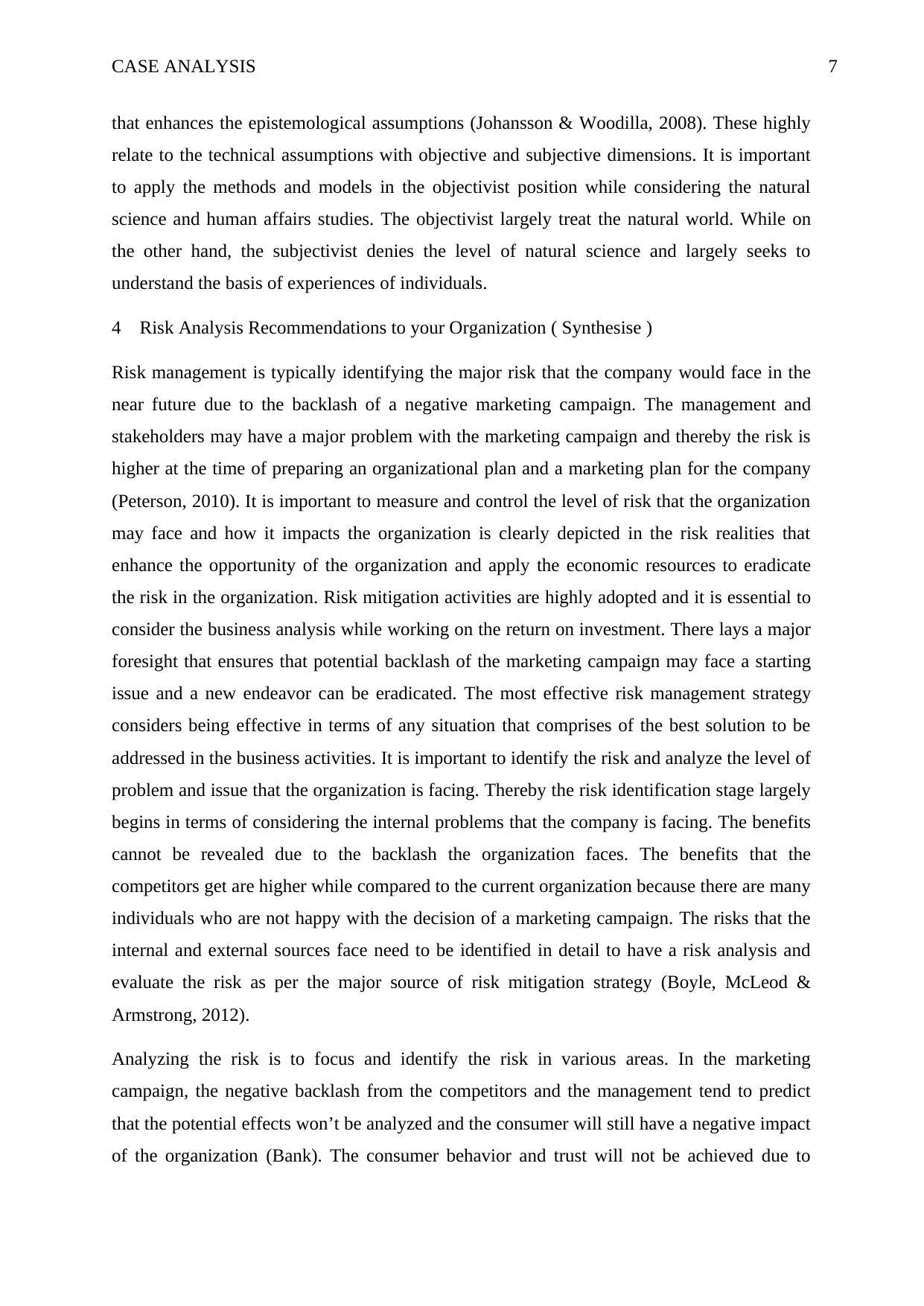
CASE ANALYSIS 7
that enhances the epistemological assumptions (Johansson & Woodilla, 2008). These highly
relate to the technical assumptions with objective and subjective dimensions. It is important
to apply the methods and models in the objectivist position while considering the natural
science and human affairs studies. The objectivist largely treat the natural world. While on
the other hand, the subjectivist denies the level of natural science and largely seeks to
understand the basis of experiences of individuals.
4 Risk Analysis Recommendations to your Organization ( Synthesise )
Risk management is typically identifying the major risk that the company would face in the
near future due to the backlash of a negative marketing campaign. The management and
stakeholders may have a major problem with the marketing campaign and thereby the risk is
higher at the time of preparing an organizational plan and a marketing plan for the company
(Peterson, 2010). It is important to measure and control the level of risk that the organization
may face and how it impacts the organization is clearly depicted in the risk realities that
enhance the opportunity of the organization and apply the economic resources to eradicate
the risk in the organization. Risk mitigation activities are highly adopted and it is essential to
consider the business analysis while working on the return on investment. There lays a major
foresight that ensures that potential backlash of the marketing campaign may face a starting
issue and a new endeavor can be eradicated. The most effective risk management strategy
considers being effective in terms of any situation that comprises of the best solution to be
addressed in the business activities. It is important to identify the risk and analyze the level of
problem and issue that the organization is facing. Thereby the risk identification stage largely
begins in terms of considering the internal problems that the company is facing. The benefits
cannot be revealed due to the backlash the organization faces. The benefits that the
competitors get are higher while compared to the current organization because there are many
individuals who are not happy with the decision of a marketing campaign. The risks that the
internal and external sources face need to be identified in detail to have a risk analysis and
evaluate the risk as per the major source of risk mitigation strategy (Boyle, McLeod &
Armstrong, 2012).
Analyzing the risk is to focus and identify the risk in various areas. In the marketing
campaign, the negative backlash from the competitors and the management tend to predict
that the potential effects won’t be analyzed and the consumer will still have a negative impact
of the organization (Bank). The consumer behavior and trust will not be achieved due to
that enhances the epistemological assumptions (Johansson & Woodilla, 2008). These highly
relate to the technical assumptions with objective and subjective dimensions. It is important
to apply the methods and models in the objectivist position while considering the natural
science and human affairs studies. The objectivist largely treat the natural world. While on
the other hand, the subjectivist denies the level of natural science and largely seeks to
understand the basis of experiences of individuals.
4 Risk Analysis Recommendations to your Organization ( Synthesise )
Risk management is typically identifying the major risk that the company would face in the
near future due to the backlash of a negative marketing campaign. The management and
stakeholders may have a major problem with the marketing campaign and thereby the risk is
higher at the time of preparing an organizational plan and a marketing plan for the company
(Peterson, 2010). It is important to measure and control the level of risk that the organization
may face and how it impacts the organization is clearly depicted in the risk realities that
enhance the opportunity of the organization and apply the economic resources to eradicate
the risk in the organization. Risk mitigation activities are highly adopted and it is essential to
consider the business analysis while working on the return on investment. There lays a major
foresight that ensures that potential backlash of the marketing campaign may face a starting
issue and a new endeavor can be eradicated. The most effective risk management strategy
considers being effective in terms of any situation that comprises of the best solution to be
addressed in the business activities. It is important to identify the risk and analyze the level of
problem and issue that the organization is facing. Thereby the risk identification stage largely
begins in terms of considering the internal problems that the company is facing. The benefits
cannot be revealed due to the backlash the organization faces. The benefits that the
competitors get are higher while compared to the current organization because there are many
individuals who are not happy with the decision of a marketing campaign. The risks that the
internal and external sources face need to be identified in detail to have a risk analysis and
evaluate the risk as per the major source of risk mitigation strategy (Boyle, McLeod &
Armstrong, 2012).
Analyzing the risk is to focus and identify the risk in various areas. In the marketing
campaign, the negative backlash from the competitors and the management tend to predict
that the potential effects won’t be analyzed and the consumer will still have a negative impact
of the organization (Bank). The consumer behavior and trust will not be achieved due to
Paraphrase This Document
Need a fresh take? Get an instant paraphrase of this document with our AI Paraphraser
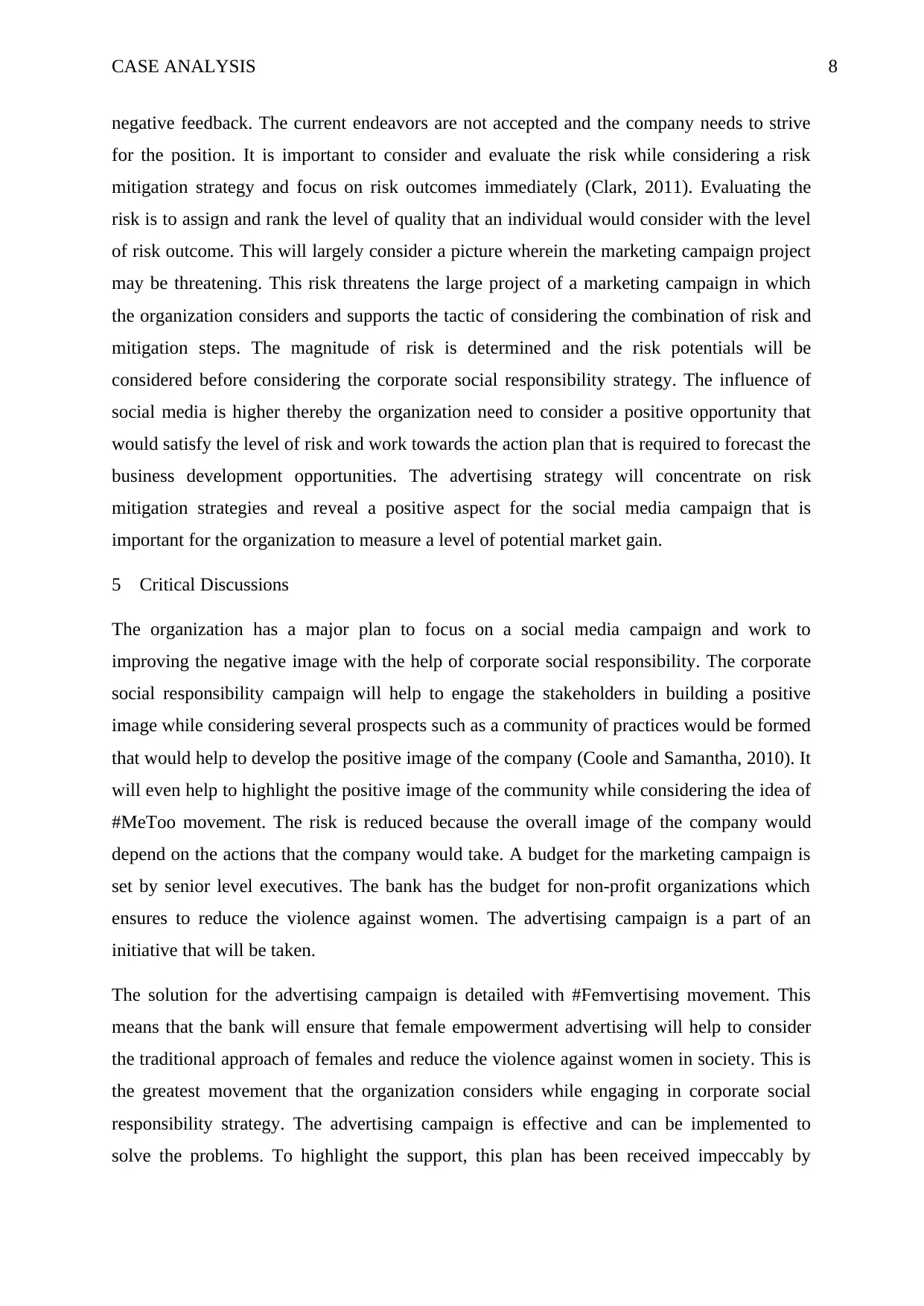
CASE ANALYSIS 8
negative feedback. The current endeavors are not accepted and the company needs to strive
for the position. It is important to consider and evaluate the risk while considering a risk
mitigation strategy and focus on risk outcomes immediately (Clark, 2011). Evaluating the
risk is to assign and rank the level of quality that an individual would consider with the level
of risk outcome. This will largely consider a picture wherein the marketing campaign project
may be threatening. This risk threatens the large project of a marketing campaign in which
the organization considers and supports the tactic of considering the combination of risk and
mitigation steps. The magnitude of risk is determined and the risk potentials will be
considered before considering the corporate social responsibility strategy. The influence of
social media is higher thereby the organization need to consider a positive opportunity that
would satisfy the level of risk and work towards the action plan that is required to forecast the
business development opportunities. The advertising strategy will concentrate on risk
mitigation strategies and reveal a positive aspect for the social media campaign that is
important for the organization to measure a level of potential market gain.
5 Critical Discussions
The organization has a major plan to focus on a social media campaign and work to
improving the negative image with the help of corporate social responsibility. The corporate
social responsibility campaign will help to engage the stakeholders in building a positive
image while considering several prospects such as a community of practices would be formed
that would help to develop the positive image of the company (Coole and Samantha, 2010). It
will even help to highlight the positive image of the community while considering the idea of
#MeToo movement. The risk is reduced because the overall image of the company would
depend on the actions that the company would take. A budget for the marketing campaign is
set by senior level executives. The bank has the budget for non-profit organizations which
ensures to reduce the violence against women. The advertising campaign is a part of an
initiative that will be taken.
The solution for the advertising campaign is detailed with #Femvertising movement. This
means that the bank will ensure that female empowerment advertising will help to consider
the traditional approach of females and reduce the violence against women in society. This is
the greatest movement that the organization considers while engaging in corporate social
responsibility strategy. The advertising campaign is effective and can be implemented to
solve the problems. To highlight the support, this plan has been received impeccably by
negative feedback. The current endeavors are not accepted and the company needs to strive
for the position. It is important to consider and evaluate the risk while considering a risk
mitigation strategy and focus on risk outcomes immediately (Clark, 2011). Evaluating the
risk is to assign and rank the level of quality that an individual would consider with the level
of risk outcome. This will largely consider a picture wherein the marketing campaign project
may be threatening. This risk threatens the large project of a marketing campaign in which
the organization considers and supports the tactic of considering the combination of risk and
mitigation steps. The magnitude of risk is determined and the risk potentials will be
considered before considering the corporate social responsibility strategy. The influence of
social media is higher thereby the organization need to consider a positive opportunity that
would satisfy the level of risk and work towards the action plan that is required to forecast the
business development opportunities. The advertising strategy will concentrate on risk
mitigation strategies and reveal a positive aspect for the social media campaign that is
important for the organization to measure a level of potential market gain.
5 Critical Discussions
The organization has a major plan to focus on a social media campaign and work to
improving the negative image with the help of corporate social responsibility. The corporate
social responsibility campaign will help to engage the stakeholders in building a positive
image while considering several prospects such as a community of practices would be formed
that would help to develop the positive image of the company (Coole and Samantha, 2010). It
will even help to highlight the positive image of the community while considering the idea of
#MeToo movement. The risk is reduced because the overall image of the company would
depend on the actions that the company would take. A budget for the marketing campaign is
set by senior level executives. The bank has the budget for non-profit organizations which
ensures to reduce the violence against women. The advertising campaign is a part of an
initiative that will be taken.
The solution for the advertising campaign is detailed with #Femvertising movement. This
means that the bank will ensure that female empowerment advertising will help to consider
the traditional approach of females and reduce the violence against women in society. This is
the greatest movement that the organization considers while engaging in corporate social
responsibility strategy. The advertising campaign is effective and can be implemented to
solve the problems. To highlight the support, this plan has been received impeccably by
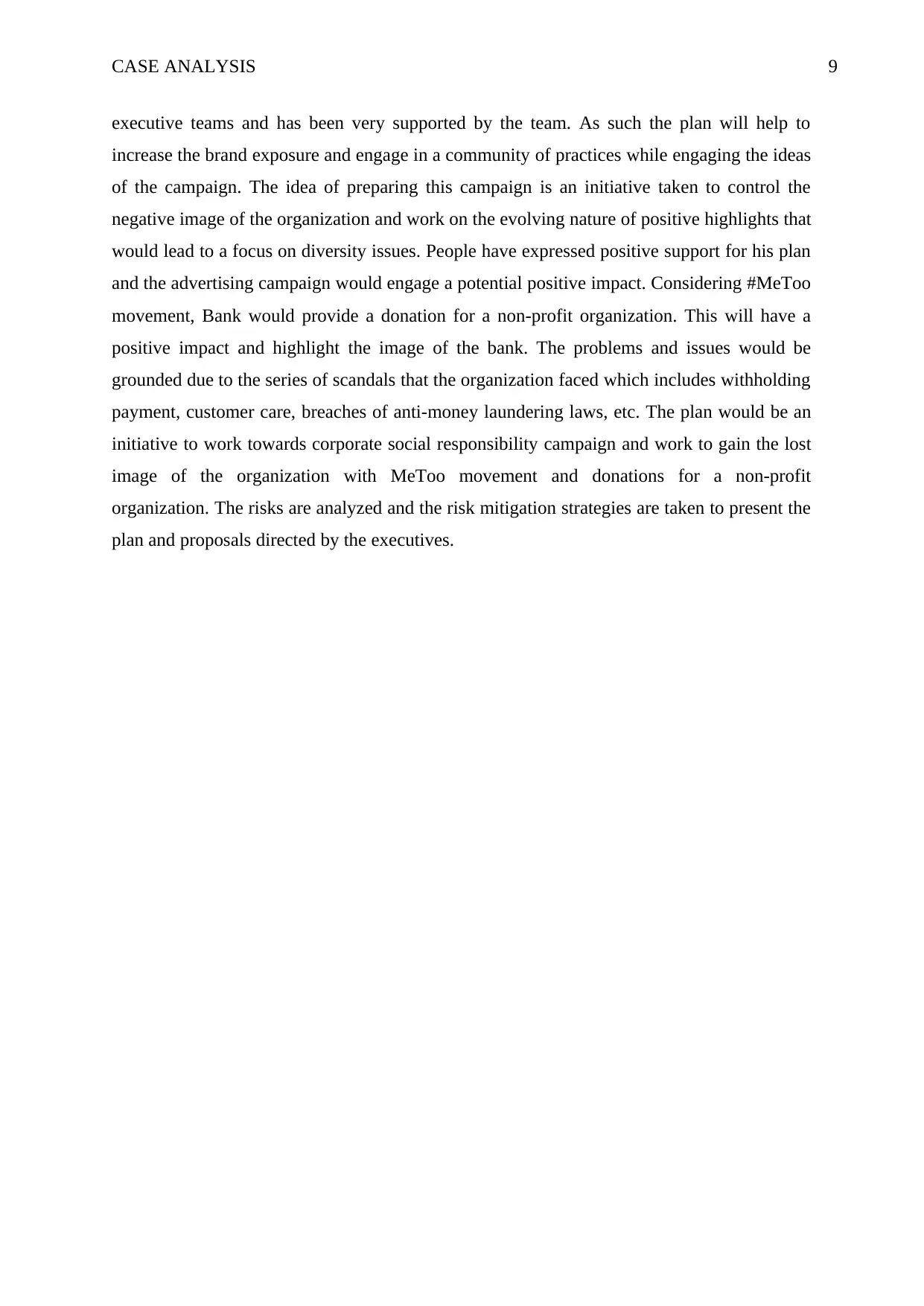
CASE ANALYSIS 9
executive teams and has been very supported by the team. As such the plan will help to
increase the brand exposure and engage in a community of practices while engaging the ideas
of the campaign. The idea of preparing this campaign is an initiative taken to control the
negative image of the organization and work on the evolving nature of positive highlights that
would lead to a focus on diversity issues. People have expressed positive support for his plan
and the advertising campaign would engage a potential positive impact. Considering #MeToo
movement, Bank would provide a donation for a non-profit organization. This will have a
positive impact and highlight the image of the bank. The problems and issues would be
grounded due to the series of scandals that the organization faced which includes withholding
payment, customer care, breaches of anti-money laundering laws, etc. The plan would be an
initiative to work towards corporate social responsibility campaign and work to gain the lost
image of the organization with MeToo movement and donations for a non-profit
organization. The risks are analyzed and the risk mitigation strategies are taken to present the
plan and proposals directed by the executives.
executive teams and has been very supported by the team. As such the plan will help to
increase the brand exposure and engage in a community of practices while engaging the ideas
of the campaign. The idea of preparing this campaign is an initiative taken to control the
negative image of the organization and work on the evolving nature of positive highlights that
would lead to a focus on diversity issues. People have expressed positive support for his plan
and the advertising campaign would engage a potential positive impact. Considering #MeToo
movement, Bank would provide a donation for a non-profit organization. This will have a
positive impact and highlight the image of the bank. The problems and issues would be
grounded due to the series of scandals that the organization faced which includes withholding
payment, customer care, breaches of anti-money laundering laws, etc. The plan would be an
initiative to work towards corporate social responsibility campaign and work to gain the lost
image of the organization with MeToo movement and donations for a non-profit
organization. The risks are analyzed and the risk mitigation strategies are taken to present the
plan and proposals directed by the executives.
⊘ This is a preview!⊘
Do you want full access?
Subscribe today to unlock all pages.

Trusted by 1+ million students worldwide
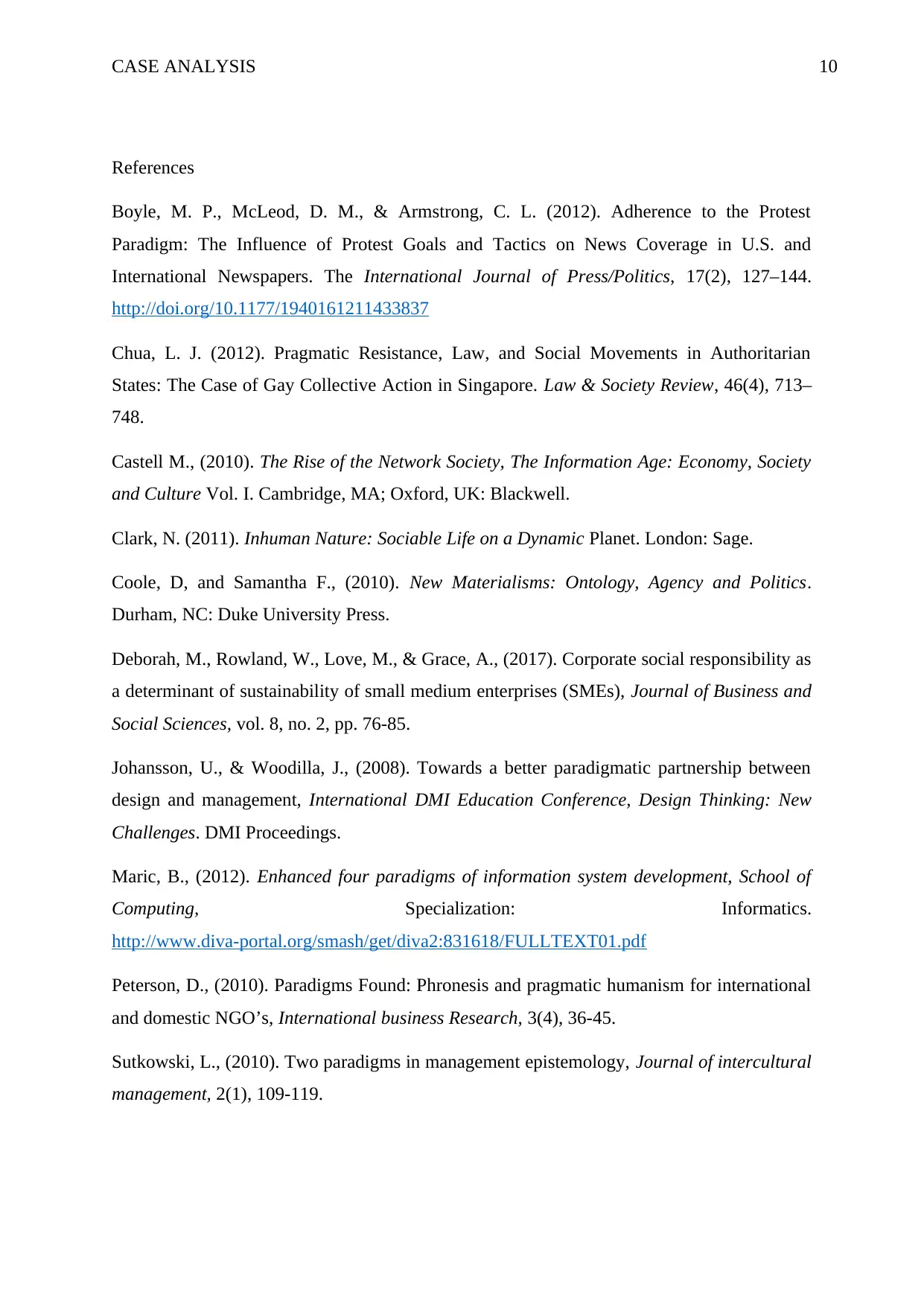
CASE ANALYSIS 10
References
Boyle, M. P., McLeod, D. M., & Armstrong, C. L. (2012). Adherence to the Protest
Paradigm: The Influence of Protest Goals and Tactics on News Coverage in U.S. and
International Newspapers. The International Journal of Press/Politics, 17(2), 127–144.
http://doi.org/10.1177/1940161211433837
Chua, L. J. (2012). Pragmatic Resistance, Law, and Social Movements in Authoritarian
States: The Case of Gay Collective Action in Singapore. Law & Society Review, 46(4), 713–
748.
Castell M., (2010). The Rise of the Network Society, The Information Age: Economy, Society
and Culture Vol. I. Cambridge, MA; Oxford, UK: Blackwell.
Clark, N. (2011). Inhuman Nature: Sociable Life on a Dynamic Planet. London: Sage.
Coole, D, and Samantha F., (2010). New Materialisms: Ontology, Agency and Politics.
Durham, NC: Duke University Press.
Deborah, M., Rowland, W., Love, M., & Grace, A., (2017). Corporate social responsibility as
a determinant of sustainability of small medium enterprises (SMEs), Journal of Business and
Social Sciences, vol. 8, no. 2, pp. 76-85.
Johansson, U., & Woodilla, J., (2008). Towards a better paradigmatic partnership between
design and management, International DMI Education Conference, Design Thinking: New
Challenges. DMI Proceedings.
Maric, B., (2012). Enhanced four paradigms of information system development, School of
Computing, Specialization: Informatics.
http://www.diva-portal.org/smash/get/diva2:831618/FULLTEXT01.pdf
Peterson, D., (2010). Paradigms Found: Phronesis and pragmatic humanism for international
and domestic NGO’s, International business Research, 3(4), 36-45.
Sutkowski, L., (2010). Two paradigms in management epistemology, Journal of intercultural
management, 2(1), 109-119.
References
Boyle, M. P., McLeod, D. M., & Armstrong, C. L. (2012). Adherence to the Protest
Paradigm: The Influence of Protest Goals and Tactics on News Coverage in U.S. and
International Newspapers. The International Journal of Press/Politics, 17(2), 127–144.
http://doi.org/10.1177/1940161211433837
Chua, L. J. (2012). Pragmatic Resistance, Law, and Social Movements in Authoritarian
States: The Case of Gay Collective Action in Singapore. Law & Society Review, 46(4), 713–
748.
Castell M., (2010). The Rise of the Network Society, The Information Age: Economy, Society
and Culture Vol. I. Cambridge, MA; Oxford, UK: Blackwell.
Clark, N. (2011). Inhuman Nature: Sociable Life on a Dynamic Planet. London: Sage.
Coole, D, and Samantha F., (2010). New Materialisms: Ontology, Agency and Politics.
Durham, NC: Duke University Press.
Deborah, M., Rowland, W., Love, M., & Grace, A., (2017). Corporate social responsibility as
a determinant of sustainability of small medium enterprises (SMEs), Journal of Business and
Social Sciences, vol. 8, no. 2, pp. 76-85.
Johansson, U., & Woodilla, J., (2008). Towards a better paradigmatic partnership between
design and management, International DMI Education Conference, Design Thinking: New
Challenges. DMI Proceedings.
Maric, B., (2012). Enhanced four paradigms of information system development, School of
Computing, Specialization: Informatics.
http://www.diva-portal.org/smash/get/diva2:831618/FULLTEXT01.pdf
Peterson, D., (2010). Paradigms Found: Phronesis and pragmatic humanism for international
and domestic NGO’s, International business Research, 3(4), 36-45.
Sutkowski, L., (2010). Two paradigms in management epistemology, Journal of intercultural
management, 2(1), 109-119.
Paraphrase This Document
Need a fresh take? Get an instant paraphrase of this document with our AI Paraphraser

CASE ANALYSIS 11
Saeed, M., Arshad, F., (2012). Corporate social responsibility as a source of competitive
advantage: The mediating role of social capital and reputational capital. Journal of database
marketing and customer strategy management, vol. 19, no. 4, pp. 219-232.
Waele D.M., (2010). Governing the World: The Ethical Imperative. Trafford Publishing.
Saeed, M., Arshad, F., (2012). Corporate social responsibility as a source of competitive
advantage: The mediating role of social capital and reputational capital. Journal of database
marketing and customer strategy management, vol. 19, no. 4, pp. 219-232.
Waele D.M., (2010). Governing the World: The Ethical Imperative. Trafford Publishing.
1 out of 11
Related Documents
Your All-in-One AI-Powered Toolkit for Academic Success.
+13062052269
info@desklib.com
Available 24*7 on WhatsApp / Email
![[object Object]](/_next/static/media/star-bottom.7253800d.svg)
Unlock your academic potential
Copyright © 2020–2025 A2Z Services. All Rights Reserved. Developed and managed by ZUCOL.





